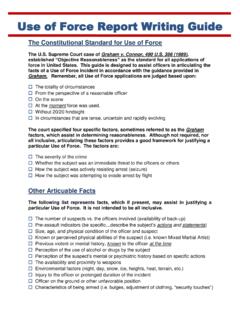Transcription of Guide-Writing Testable Code - Misko Hevery
1 guide : writing Testable code To keep our code at Google in the best possible shape we provided our software engineers with these constant reminders. Now, we are happy to share them with the world. Many thanks to these folks for inspiration and hours of hard work getting this guide done: Jonathan Wolter Russ Ruffer Mi ko Hevery Available online at: 2 Contents Why this is a Flaw .. 3 Recognizing the Flaw .. 4 Fixing the Flaw .. 5 Concrete code Examples Before and After .. 6 Frequently Asked Questions .. 15 Flaw: Digging into Collaborators .. 16 Why this is a Flaw .. 16 Recognizing the Flaw .. 17 Fixing the Flaw .. 17 Concrete code Examples Before and After .. 17 When This is not a Flaw: .. 22 Why this is a Flaw .. 23 Recognizing the Flaw .. 27 Fixing the Flaw .. 28 Concrete code Examples Before and After .. 29 Caveat: When is Global State OK? .. 34 Flaw: Class Does Too Much .. 36 Why this is a Flaw .. 36 Recognizing the Flaw .. 37 Fixing the Flaw.
2 38 Caveat: Living with the Flaw .. 38 3 Flaw: Constructor does Real Work Work in the constructor such as: creating/initializing collaborators, communicating with other services, and logic to set up its own state removes seams needed for testing, forcing subclasses/mocks to inherit unwanted behavior. Too much work in the constructor prevents instantiation or altering collaborators in the test. Warning Signs: new keyword in a constructor or at field declaration Static method calls in a constructor or at field declaration Anything more than field assignment in constructors Object not fully initialized after the constructor finishes (watch out for initialize methods) Control flow (conditional or looping logic) in a constructor CL does complex object graph construction inside a constructor rather than using a factory or builder Adding or using an initialization block Why this is a Flaw When your constructor has to instantiate and initialize its collaborators, the result tends to be an inflexible and prematurely coupled design.
3 Such constructors shut off the ability to inject test collaborators when testing. It violates the Single Responsibility Principle When collaborator construction is mixed with initialization, it suggests that there is only one way to configure the class, which closes off reuse opportunities that might otherwise be available. Object graph creation is a full fledged responsibility a different one from why a class exists in the first place. Doing such work in a constructor violates the Single Responsibility Principle. Testing Directly is Difficult Testing such constructors is difficult. To instantiate an object, the constructor must execute. And if that constructor does lots of work, you are forced to do that work when creating the object in tests. If collaborators access external resources ( files, network services, or databases), subtle changes in collaborators may need to be reflected in the constructor, but may be missed due to missing test coverage from tests that weren t written because the constructor is so difficult to test.
4 We end up in a vicious cycle. Subclassing and Overriding to Test is Still Flawed Other times a constructor does little work itself, but delegates to a method that is expected to be overridden in a test subclass. This may work around the problem of difficult construction, but using the subclass to test trick is something you only should do as a last resort. Additionally, by subclassing, you will fail to test the method that you override. And that method does lots of work (remember - that s why it was created in the first place), so it probably should be tested. 4 It Forces Collaborators on You Sometimes when you test an object, you don t want to actually create all of its collaborators. For instance, you don t want a real MySqlRepository object that talks to the MySql service. However, if they are directly created using new MySqlRepositoryServiceThatTalksToOtherSe rvers() inside your System Under Test (SUT), then you will be forced to use that heavyweight object.
5 It Erases a Seam Seams are places you can slice your codebase to remove dependencies and instantiate small, focused objects. When you do new XYZ() in a constructor, you ll never be able to get a different (subclass) object created. (See Michael Feathers book Working Effectively with Legacy code for more about seams). It Still is a Flaw even if you have Multiple Constructors (Some for Test Only ) Creating a separate test only constructor does not solve the problem. The constructors that do work will still be used by other classes. Even if you can test this object in isolation (creating it with the test specific constructor), you re going to run into other classes that use the hard-to-test constructor. And when testing those other classes, your hands will be tied. Bottom Line It all comes down to how hard or easy it is to construct the class in isolation or with test-double collaborators. If it s hard, you re doing too much work in the constructor!
6 If it s easy, pat yourself on the back. Always think about how hard it will be to test the object while you are writing it. Will it be easy to instantiate it via the constructor you re writing ? (Keep in mind that your test-class will not be the only code where this class will be instantiated.) So many designs are full of objects that instantiate other objects or retrieve objects from globally accessible locations. These programming practices, when left unchecked, lead to highly coupled designs that are difficult to test. * Rainsberger, JUnit Recipes, Recipe ] Recognizing the Flaw Examine for these symptoms: The new keyword constructs anything you would like to replace with a test-double in a test? (Typically this is anything bigger than a simple value object). Any static method calls? (Remember: static calls are non-mockable, and non-injectable, so if you see () or anything of that ilk, warning sirens should go off in your head!)
7 Any conditional or loop logic? (You will have to successfully navigate the logic every time you instantiate the object. This will result in excessive setup code not only when you test the class directly, but also if you happen to need this class while testing any of the related classes.) 5 Think about one fundamental question when writing or reviewing code : How am I going to test this? If the answer is not obvious, or it looks like the test would be ugly or hard to write, then take that as a warning signal. Your design probably needs to be modified; change things around until the code is easy to test, and your design will end up being far better for the effort. [Hunt, Thomas. Pragmatic Unit Testing in Java with JUnit, p 103 (somewhat dated, but a decent and quick read)] Note: Constructing value objects may be acceptable in many cases (examples: LinkedList; HashMap, User, EmailAddress, CreditCard). Value objects key attributes are: (1) Trivial to construct (2) are state focused (lots of getters/setters low on behavior) (3) do not refer to any service object.
8 Fixing the Flaw Do not create collaborators in your constructor, but pass them in Move the responsibility for object graph construction and initialization into another object. ( extract a builder, factory or Provider, and pass these collaborators to your constructor). Example: If you depend on a DatabaseService (hopefully that s an interface), then use Dependency Injection (DI) to pass in to the constructor the exact subclass of DatabaseService object you need. To repeat: Do not create collaborators in your constructor, but pass them in. (Don t look for things! Ask for things!) If there is initialization that needs to happen with the objects that get passed in, you have three options: 1. Best Approach using Guice: Use a Provider<YourObject> to create and initialize YourObject s constructor arguments. Leave the responsibility of object initialization and graph construction to Guice. This will remove the need to initialize the objects on-the-go.
9 Sometimes you will use Builders or Factories in addition to Providers, then pass in the builders and factories to the constructor. 2. Best Approach using manual Dependency Injection: Use a Builder, or a Factory, for YourObject s constructor arguments. Typically there is one factory for a whole graph of objects, see example below. (So you don t have to worry about having class explosion due to one factory for every class) The responsibility of the factory is to create the object graph and to do no work. (All you should see in the factory is a whole lot of new keywords and passing around of references). The responsibility of the object graph is to do work, and to do no object instantiation (There should be a serious lack of new keywords in application logic classes). 3. Only as a Last Resort: Have an init(..) method in your class that can be called after construction. Avoid this wherever you can, preferring the use of another object who s single responsibility is to configure the parameters for this object.
10 (Often that is a Provider if you are using Guice) (Also read the code examples below) 6 Concrete code Examples Before and After Fundamentally, Work in the Constructor amounts to doing anything that makes instantiating your object difficult or introducing test-double objects difficult. Problem: new Keyword in the Constructor or at Field Declaration Before: Hard to Test After: Testable and Flexible Design // Basic new operators called directly in // the class' constructor. (Forever // preventing a seam to create different // kitchen and bedroom collaborators). class House { Kitchen kitchen = new Kitchen(); Bedroom bedroom; House() { bedroom = new Bedroom(); } // .. } class House { Kitchen kitchen; Bedroom bedroom; // Have Guice create the objects // and pass them in @Inject House(Kitchen k, Bedroom b) { kitchen = k; bedroom = b; } // .. } // An attempted test that becomes pretty hard class HouseTest extends TestCase { public void testThisIsReallyHard() { House house = new House(); // Darn!}}








